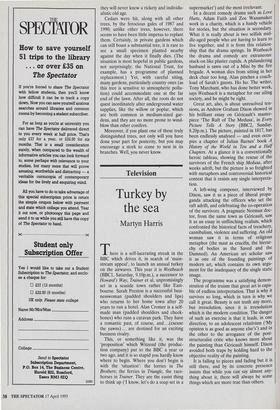Television
Turkey by the sea
Martyn Harris
There is a self-lacerating streak in the BBC which drives it, in search of 'main- stream appeal', to launch an annual turkey on the airwaves. This year it is Westbeach (BBC1, Saturday, 9.10p.m.), a successor to Howard's Way, Trainer et al, unpromisingly set in a seaside town rather like East- bourne. Sarah Preston is a successful busi- nesswoman (padded shoulders and lips) who returns to her home town after 20 years to run a hotel. Alan Cromer is a self- made man (padded shoulders and cheek- bones) who runs a caravan park. They have a romantic past, of course, and ...(excuse the yawns)... are destined for an exciting business rivalry.
This, or something like it, was the `proposition' which Witzend (the produc- tion company) put to the BBC a year or two ago, and it is so stupid you hardly know where to begin. Where you don't begin is with the 'situation': the lorries in The Brothers; the ferries in Triangle, the race- horses in Trainer. They are the easist thing to think up CI know, let's do a soap set in a
supermarket') and the most irrelevant.
In a decent comedy drama such as Love Hurts, Adam Faith and Zoe Wanamaker
work in a charity, which is a handy vehicle for stories, but the situation is secondary. What it is really about is two selfish mid- dle-aged people who are having to learn to
live together, and it is from this relation- ship that the drama springs. In Westbeach
the drama and comedy are extraneous: stuck-on like plaster cupids. A philandering husband is sawn out of a Mini by the fire brigade. A woman dies from sitting in her deck chair too long. Alan pinches a coach- load of Sarah's guests. Ho ho. The writer,
Tony Marchant, who has done better work, says Westbeach is a metaphor for our ailing society, and he might be right.
Great art, also, is about unresolved ten- sions, as Andrew Graham Dixon showed in his brilliant essay on Gericaules master-
piece 'The Raft of The Medusa', in Every Picture Tells A Story (BBC2, Sunday, 8.20p.m.). The picture, painted in 1817, has been endlessly analysed — and even occu- pies a chapter of Julian Barnes' book A History of the World in Ten and a Half Chapters. At a glance it is a conventionally
heroic tableau, showing the rescue of the
survivors of the French ship Medusa, after weeks adrift, but the picture is so freighted
with metaphors. and controversial historical context that it resists any single interpreta- tion.
A left-wing composer, interviewed by Dixon, saw it as a piece of liberal propa- ganda attacking the officers who set the raft adrift, and celebrating the co-operation of the survivors. A pragmatic Norman doc- tor, from the same town as Gericault, saw it as an essay in unflinching realism, which confronted the historical facts of treachery, cannibalism, violence and suffering. An old woman saw it in terms of religious metaphor (the mast as crucifix, the hierar- chy of bodies as the Saved and the Damned). An American art scholar saw it as one of the founding paintings of modern art, which contains its own argu- ment for the inadequacy of the single static image.
The programme was a satisfying demon- stration of the truism that great art is capa- ble of endless interpretation. That is why it survives so long, which in turn is why we call it great. Beauty is not truth any more, but irresolution, since it is irresolution which is the modern condition. The danger of such an exercise is that it leads, in one
direction, to an adolescent relativism (`My
opinion is as good as anyone else's') and in the other to the arrogance of the post- structuralist critic who knows more about the painting than Gericault himself. Dixon avoided both traps by holding hard to the objective reality of the painting. It is falling to pieces and fading but it is still there, and by its concrete presence insists that while you can say almost any- thing about it, there will always be some things which are more true than others.


















































 Previous page
Previous page